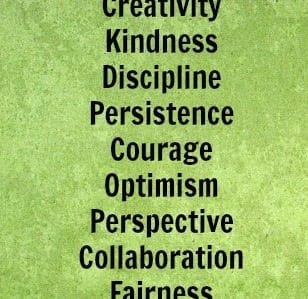How to Identify and Maximize Your Unique Talents and Strengths as an Educator
By Samantha Cleaver
 When Sherida Britt taught high-school English, her strengths were in providing instruction and designing curricula, not in creating bulletin boards and planning classroom projects. But when she noticed the warm environments that other teachers had created, she worried about her bare classroom and sought out other teachers’ help in sprucing up her room. Now, as a Director of Tools for Teachers with ASCD, Britt calls her experience typical. As teachers, we often spend time devoted to turning our weaknesses around when we should be focusing on what we already bring to our students: our own particular approach to the classroom.
When Sherida Britt taught high-school English, her strengths were in providing instruction and designing curricula, not in creating bulletin boards and planning classroom projects. But when she noticed the warm environments that other teachers had created, she worried about her bare classroom and sought out other teachers’ help in sprucing up her room. Now, as a Director of Tools for Teachers with ASCD, Britt calls her experience typical. As teachers, we often spend time devoted to turning our weaknesses around when we should be focusing on what we already bring to our students: our own particular approach to the classroom.
More Than One Way to Teach
Teachers aren’t defined by one specific set of characteristics. “There’s no cookie-cutter template for teachers,” says Britt. “The most important thing is to know your strengths.” Trust in who you are as a teacher and let it shape your experience, from lesson-planning to instruction. “When teachers leverage their strengths in the classroom,” says Carol Vernon, certified executive coach with Communication Matters, “they are more naturally engaged with their students and students know it!”
On the flip slide, it’s not productive to focus on what you don’t do well, because, let’s face it, everyone has weaknesses. “If you just focus on what’s wrong, that doesn’t create excellence,” says Kristin Gregory, senior strengths consultant with Gallup, ““our greatest opportunity for significant and fast improvement lies in our strengths.”
Identifying Your Strengths as a Teacher
Your teaching is shaped by your strengths. “One way to identify them to yourself,” says Vernon, “is to identify the activities that you do regularly that make you most energized and engaged.” Strengths are the traits that you find yourself coming back to again and again, regardless of what you may have originally planned. In contrast, the types of activities that you find most draining, or the ones you never do, may rely too much on skills that you have not fully developed. For example, one teacher may thrive at teaching in an active and noisy classroom, another may prefer to instruct via quieter, more focused classroom discussions.
 We all want to make up for our weaknesses, but there’s little point in trying to go completely against your grain. “In the classroom,” says Britt, “your students want and need you to be authentic, and know when you’re trying to be something you’re not.”
We all want to make up for our weaknesses, but there’s little point in trying to go completely against your grain. “In the classroom,” says Britt, “your students want and need you to be authentic, and know when you’re trying to be something you’re not.”
Of course, as a teacher, you naturally engage with lots of different personalities. And, at some point, your personality may clash with the personality of one of your student’s. “When this happens,” says Britt, “it’s important to remember that you are dealing with human beings who are developing and growing, so there may be a need to adjust your style so that you can support all learners.” Regardless of your natural strengths, it’s also important to be flexible and adjust when necessary. “Students who challenge you,” says Britt, “provide a wonderful opportunity for you to grow and adjust.”
If you want to learn more about your strengths, the first step is to know yourself. “Good teaching comes from a strong sense of self,” says Britt. Jot down notes about the activities that excite you (they’re probably the ones that get checked off your to-do list first), and those that you consider drudgery. Make note of observations from other teachers about how you teach. For example, do they comment on your organization, your humor or your creativity? And, consider inviting other teachers to observe and give you feedback on your strengths in the classroom.
Take our “Teaching Strengths Quiz” and discover your five strongest qualities as an educator. Then read on for ideas on how to use each strength to its best advantage.
- Teaching Strength: Creativity
Definition: You’re constantly thinking of new and interesting ways to conceptualize ideas and planning new projects.
Use It: Creative thinking can be taught. Model creative thinking, such as synthesizing multiple sources into a new idea, for your students. Then, challenge your students to be content creators by giving them a project to work on that requires them to review and integrate lots of information to create something new such as a book or presentation. Make sure, however, there’s no “right” answer. - Teaching Strength: Curiosity
Definition: You’re always interested in exploring and discovering new things. You want to experience things just to have done them.
Use It: Curiosity is all about asking questions. See how many questions your students can come up with around one broad topic or essential question: What is fire? How do dolphins communicate? How can we solve global warming? Introduce famous mysteries from history/literature and see what questions emerge? Post the questions and comments on sticky notes or notecards and watch students’ curiosity spread across the room. - Teaching Strength: Open-Mindedness
Definition: You enjoy hearing about and thinking about new ideas.
Use It: Try a Consider-It Cube. Using a cube cut-out, write an idea or proposition in the center (i.e., “we should elect a class president”) and have students consider five different ways to think about that idea, from different perspectives or toward different goals. Students can use the completed cubes to discuss and debate different ideas. - Teaching Strength: Perspective
Definition: You’re able to make sense of complex situations and provide advice for others.
Use It: Videotape yourself explaining those tough-to-explain concepts and keep a bank online of your explanations so students (and maybe other teachers) can access them for homework, extra practice or when that concept comes up again. - Teaching Strength: Courage
Definition: You embrace challenges and act even when no one has your back.
Use It: Spend some time each week reading a newspaper clip or watching a video clip of a recent courageous act. Then, discuss what it takes to be courageous, and, as you review more courageous acts, identify similarities and differences among people who act courageously. - Teaching Strength: Persistence
Definition: You always finish what you start regardless of what road-blocks arise.
Use It: Post a math challenge problem every week that it will take students a significant amount of time to solve. Then, model persistence by showing them how you come back to the problem and encourage them to do the same until you, or a student, solves it. - Teaching Strength: Kindness
Definition: You enjoy doing work and favors for other people.
Use It: Create a structure for students to communicate what they need from and what they can give to one another. For example, if one student needs help studying for a math test, provide a way for students to communicate that (a favor chart, morning meeting announcements or request box) and time for them to demonstrate those acts of kindness. - Teaching Strength: Optimism
Definition: You always look on the bright side and are quick to turn a bad situation right side up.
Use It: Optimism creates resilience and persistence in students. Create a warm and inviting space in your classroom for students to post their goals, hopes and stories about things they have accomplished during the year. - Teaching Strength: Results Oriented
Definition: You’re focused on the end goal for each lesson, unit plan and school year.
Use It: Create charts and graphs that show and track the class’s as well as each student’s progress toward goals in reading and math. Even better, have your students track their own progress and results. - Teaching Strength: Discipline
Definition: You thrive on structure and routine and create enough organization in your classroom to manage a small country.
Use It: You know how you want everything done, but help students take over the running of your classroom with a binder of laminated “How To” instruction sheets with directions for everything from arrival to classroom jobs to rules for small group discussion. - Teaching Strength: Independence
Definition: You are not easily swayed by others and tend to prefer working on your own.
Use It: To strengthen students’ independence, create a chart with a continuum from “needed a lot of help” to “did it all by myself” that students can use to show how independent they were during a specific task. Have students track their independence during certain activities each day, for example, independent reading or math stations. - Teaching Strength: Collaboration
Definition: You work best as a member of a group.
Use It: Try collaboration stations. Just as you love collaboration best when the task isn’t easy, create projects that are genuinely challenging for your students to complete because this forces them to rely on each other. - Teaching Strength: Fairness
Definition: You put great importance on treating everyone the same.
Use It: Set up a mock trial using a text, such as the Parvana series by Deborah Ellis, or a current event, that teaches students to argue, defend and evaluate fairness in context. - Teaching Strength: Self-Control
Definition: You are able to manage and regulate what you feel and do.
Use It: It’s important for students to see self-control in action, so explain when you’re flexing your self-control muscle. Also, use your self-control to extend wait time for students during discussion, and step back from student-led discussions. - Teaching Strength: Humor
Definition: You love to laugh and make other people laugh.
Use It:Humor helps solidify student learning. Post a cartoon or joke as the morning “Do Now” assignment or “exit slip” to inject some levity into your lesson and increase the chance that students will retain it.

